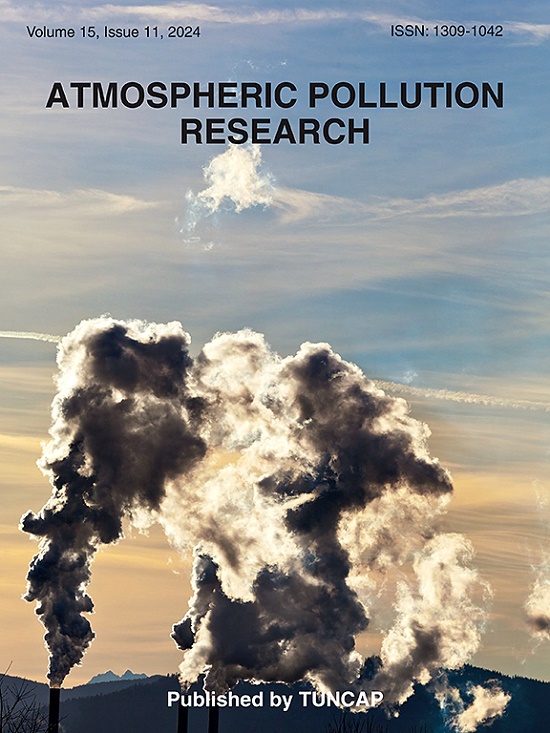Development of a spatiotemporal resolution enhancement method for satellite-observed XCH4 products based on spatiotemporal information and LightGBM-Bayesian Integration
IF 3.5
3区 环境科学与生态学
Q2 ENVIRONMENTAL SCIENCES
引用次数: 0
Abstract
High spatiotemporal resolution XCH4 observational data are crucial for the comprehensive prevention and control of CH4 pollution. Satellite remote sensing has emerged as a key approach for XCH4 monitoring; however, its effectiveness is constrained by satellite observation tracks, atmospheric disturbances, and sensor limitations. Consequently, data gaps persist in certain regions. Machine learning models have demonstrated remarkable success in generating high spatiotemporal resolution data for gases such as CO2, yet research on their application to XCH4 remains limited. Moreover, most existing studies fail to fully capture the complex spatiotemporal characteristics of XCH4 due to insufficient feature selection. Therefore, this study proposes a novel spatiotemporal resolution enhancement method for satellite-derived XCH4 data, integrating spatiotemporal information with a LightGBM-Bayesian framework. This approach establishes the latent relationships between satellite-derived XCH4 measurements, auxiliary data, and precise spatiotemporal information. Using this method, we generated XCH4 distribution maps for the Beijing-Tianjin-Hebei region from 2020 to 2022. Experimental results indicate that: (1) The LightGBM-Bayesian model outperforms traditional models such as LightGBM, XGBoost, and RF, demonstrating superior accuracy; (2) Model predictions exhibit strong consistency with TCCON station observations, validating its high precision; (3) Incorporating precise spatiotemporal information as input features significantly enhances the model's predictive performance; and (4) The spatiotemporal distribution of XCH4 in the Beijing-Tianjin-Hebei region from 2020 to 2022 reveals a seasonal trend of higher concentrations in summer and autumn and lower concentrations in spring and winter, along with a year-on-year increase. Spatial patterns indicate elevated levels in the southwest and lower levels in the northeast.
基于时空信息和LightGBM-Bayesian积分的星载XCH4产品时空分辨率增强方法研究
高时空分辨率的XCH4观测数据对CH4污染的综合防治至关重要。卫星遥感已成为XCH4监测的关键方法;然而,其有效性受到卫星观测轨迹、大气干扰和传感器限制的制约。因此,某些地区的数据差距仍然存在。机器学习模型在生成二氧化碳等气体的高时空分辨率数据方面取得了显著成功,但将其应用于XCH4的研究仍然有限。此外,由于特征选择不足,现有研究大多未能充分捕捉到XCH4复杂的时空特征。因此,本研究提出了一种将时空信息与LightGBM-Bayesian框架相结合的星载XCH4数据时空分辨率增强新方法。该方法建立了卫星衍生的XCH4测量值、辅助数据和精确时空信息之间的潜在关系。利用该方法生成了2020 - 2022年京津冀地区XCH4的分布图。实验结果表明:(1)LightGBM- bayesian模型优于传统的LightGBM、XGBoost和RF模型,具有更好的准确率;(2)模式预测结果与TCCON台站观测结果具有较强的一致性,验证了模式预测精度较高;(3)将精确的时空信息作为输入特征显著提高了模型的预测性能;(4) 2020 - 2022年京津冀地区XCH4的时空分布呈现夏秋季浓度较高、春冬季浓度较低的季节变化趋势,且呈逐年上升趋势。空间格局显示西南高,东北低。
本文章由计算机程序翻译,如有差异,请以英文原文为准。
求助全文
约1分钟内获得全文
求助全文
来源期刊

Atmospheric Pollution Research
ENVIRONMENTAL SCIENCES-
CiteScore
8.30
自引率
6.70%
发文量
256
审稿时长
36 days
期刊介绍:
Atmospheric Pollution Research (APR) is an international journal designed for the publication of articles on air pollution. Papers should present novel experimental results, theory and modeling of air pollution on local, regional, or global scales. Areas covered are research on inorganic, organic, and persistent organic air pollutants, air quality monitoring, air quality management, atmospheric dispersion and transport, air-surface (soil, water, and vegetation) exchange of pollutants, dry and wet deposition, indoor air quality, exposure assessment, health effects, satellite measurements, natural emissions, atmospheric chemistry, greenhouse gases, and effects on climate change.
 求助内容:
求助内容: 应助结果提醒方式:
应助结果提醒方式:


